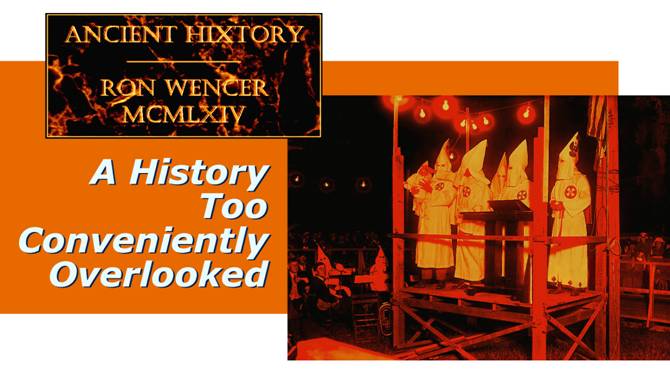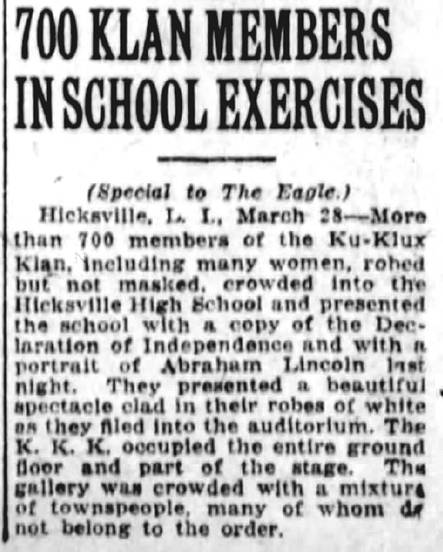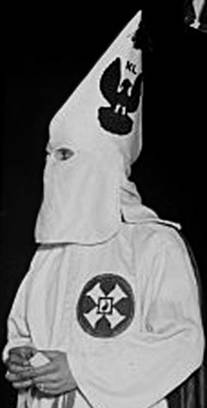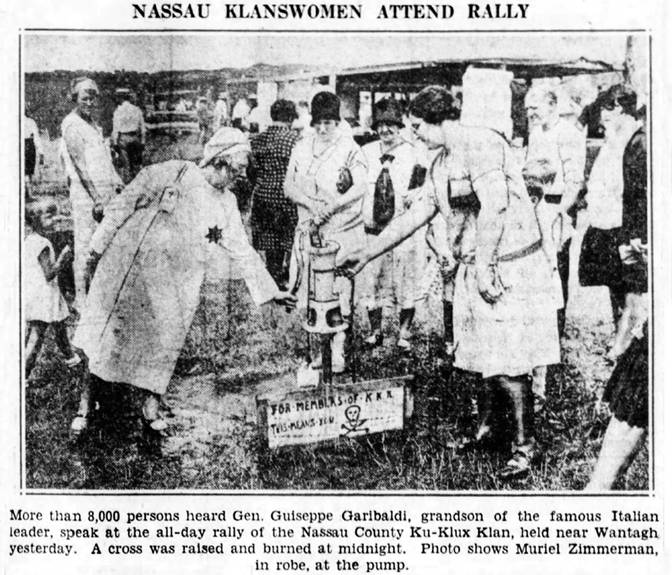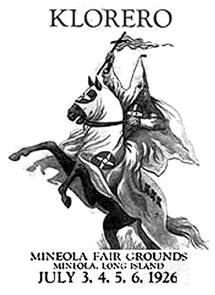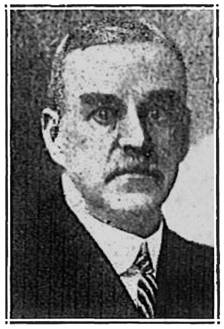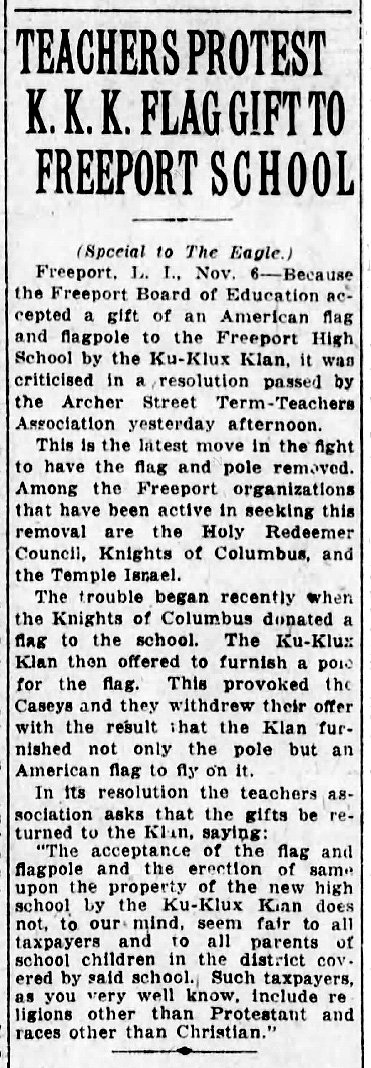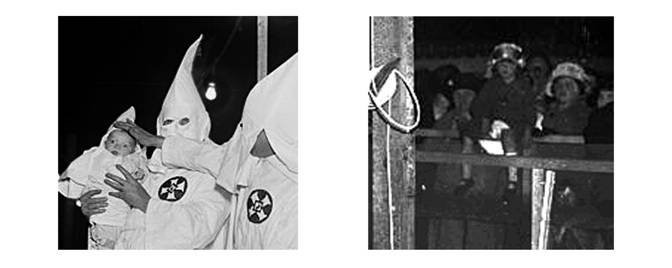|
NOVEMBER 2018
FOREWORD I
did not set out to write this article.
While researching with another topic in mind, I stumbled upon a
news story that shocked me. I
felt compelled to learn more about what was behind it, to understand its
context, and to write about it here.
Although I hope to describe objectively how things came to
happen, I cannot really accept them. *** How in the world? On a May evening in 1925, how in the
world could 5,000 people have flocked to On a night two months earlier, how in
the world could 700-plus white-robed Klan
members have proudly marched into the auditorium of the old high school
on Nicholai Street, and been welcomed by the
President of Hicksville's Board of Education?
To see if we can understand - and
there are no guarantees that we will - let's begin by looking back
at *** The 1920s Ku Klux Klan Growing up in the second half of the 20th
century, we repeatedly saw on television news that bigotry often has
been tolerated, and at times has even flourished, in At the time, many of our grandparents on Long
Island (or in Queens, or in Town by town, the Klan
gained new toe-holds. How?
One day, a Kleagle (a trained, paid organizer, and ideally a county resident)
moved into a community, and started to blend in.
As he met the townsfolk, he assessed each one, trying to identify
susceptible people whom he could recruit for the Klan.
There likely would be a few who thought that low-paid blacks or
immigrants had cost them their jobs.
There might be a merchant who faced competition from a business
run by a Catholic or Jewish owner. A
supporter of Prohibition might be outraged that her Italian neighbors
were making wine to drink with their meals. A sincere Christian might
think that local churches were not doing enough to support people who
were in need. Whatever potential vulnerability he found, a Kleagle
would exploit, using people and groups he identified according to the
contacts he had made. On
behalf of the KKK, he would send a donation to, say, a widow with young children,
who then would gratefully tell everyone she knew about the unexpected
help. He would persuade
businessmen that the Klan was
a new and superior fraternal order, a better way of networking with
others in the community to support good causes.
He would donate flags to schools or veterans' organizations.
The Kleagle would seek
a local minister who might preach to his congregation about the KKK's
support for Protestantism; if he found one, he would ask that Klan
members be invited to come to the minister's church, and present it
with a Bible or
One should not mistake the Kleagle for a missionary, or for a clergyman founding a new church;
he was a salesperson who worked on commission.
To him, recruiting meant money.
From him, his recruits bought their robes, hoods, Bibles,
pamphlets, and other paraphernalia; he kept half the profits from all
sales. When a town no longer
profited him, he moved on to start a new klavern
elsewhere. It does seem likely that some people naïvely
joined the Klan for benign
purposes, only to later regret doing so, but there is no way of knowing
to what extent that was true. For
that matter, one cannot really know the total number of people in any
given community who joined the second KKK.
Member rolls were kept secret; later interviews with former
officers yielded inconsistent figures.
Crowd estimates at public Klan
rites were only guesses - the large rallies usually happened at night
in open fields, and once the crowd reached a certain size, there was no reliable
way to estimate how big it was. Even if one allows for such
imprecision, it is disturbing to read the report in the Times
of June 22, 1923 that 25,000 people had gathered in *** Context From our perspective, the notion that anyone would
rush to join such a group without fully understanding it seems
incredible - after all, from the very beginning there were two obvious
red flags. First were the
membership restrictions: immigrants were unwelcome; Catholics were
unwelcome; Jews were unwelcome; blacks were unwelcome.
Second, at ceremonies in or near their home towns, members wore
hoods or no Klan garb at all
- they did not want their neighbors to know they were members.
Putting these two red flags together, not much imagination was
needed to foresee where things were likely headed. I reiterate that I am not trying to excuse what
happened, but rather to probe how things came to pass.
To Long Islanders in the 1920s, perhaps - only perhaps - a
mitigating factor was the everyday acceptance of many things which we
find objectionable today. Could
people truly not have known any better?
They lived in a time when ethnic, religious, racial, and gender
discrimination influenced hiring practices, and determined people's
admissibility to unions, schools, professions, and fraternal
organizations. At first
glance, the KKK may have
seemed just one more part of the status quo. 1920s *** The Klan In and Around
News reports of Klan
activities within Hicksville and in surrounding communities suggest that
these places embraced the KKK
as much as the rest of
from The
Ku Klux Klan in Sayville and Long Island at http://www.oocities.org/timmlimm/clan.htm Reading the above news items, one sees the diverse
and inconsistent faces which the Klan
presented to people - and one also sees that, in large part because of
them, it thrived in the 1920s. *** March 27, 1925 Below is a more detailed news report of the Klan
ceremony at
I have been able to learn only a little
about those named in this article. Paul
F. Lindner (spelled above as Linder) In the daytime, the Exalted Cyclops of Hempstead (also described elsewhere as the Cyclops
of Nassau County) was a well-known farmer in Malverne, who also
dabbled in politics. In
1913, he was the unsuccessful Democratic candidate for Hempstead Town
Supervisor. Afterward, the
IRS prosecuted his campaign chairman because of financing irregularities
in the campaign. Less
than a week before appearing in the ceremony at Hicksville High School,
Lindner was in the news again. A
cross had been erected and ignited on his property.
The blaze was extinguished by the local fire department, but
about an hour later, the same thing happened again.
This time, as the firemen were preparing to extinguish the
burning cross, four sticks of dynamite attached to it exploded.
The resultant crater was described as being "the size of an
automobile." The news
report stated that the firemen who were trying to extinguish the flames,
unaware of the dynamite, barely escaped serious injury. Police ascribed the incident(s) to
unknown members of the Klan,
who likely were celebrating the day's victories of three KKK-supported
candidates in a primary election. Surprisingly,
there was no mention of whether or not the police knew that Lindner was
the highest-ranking Klan
official in the Town of Several years later, a newspaper
article noted that Lindner had become the "Superintendent of Malverne
Protestant Sunday Schools." Frank
H. Smith Censuses do not seem to show any Frank
H. Smith living at this time in Rockville Centre (or anywhere else
on Long Island), nor have I found any other reference to him.
Miss Olindt also has
left behind no record of her existence.
The same is true for the mother and father whose son was
christened at the Klan rally in One suspects that KKK members sometimes adopted noms
de guerre when speaking to the press, much as they often used hoods
to conceal their identities. George
A. Duke Duke had had a long career with the Pennsylvania
Railroad, where he gradually advanced from an entry-level brakeman
position to his final position, Manager
of Baggage Handling at
As a candidate, Duke's main platform plank
appears to have been a promise to discover the cause of high faculty
turnover at the School. His
supporters argued that his daughter's being a *** Conclusion Obviously, the KKK receded as the years passed.
Did it leave any lasting stain on the community?
Did the School Board's welcome imbue the Klan
with legitimacy in the eyes of some parents or students, and reinforce
their feelings of bigotry? One
hopes not, but in hindsight it is concerning that no one in Some months before Hicksville hosted
its ceremony, the board in
I think that many of us would take even
more pride in *** Post Script This is a little mockery of the Klan,
published in the Brooklyn Eagle:
*** Notes The photograph used in this article's
title block, part of which also was used for the picture of the Kleagle, was NOT taken in Hicksville, but elsewhere on
It is both fascinating and disturbing
to look examine this picture. For
example, in the shadows on the far right (perhaps an appropriate
location) stands a mother, whose young daughter sits on a railing in
order to better view the proceedings.
One wonders into what sort of adults these small children grew. Sources Most of the material in this article
has been abstracted from news stories which appeared in 1920s in the For more information, the following
sources are worth consulting:
|
|||||||||||||||||||||||||||||||||||||||||
